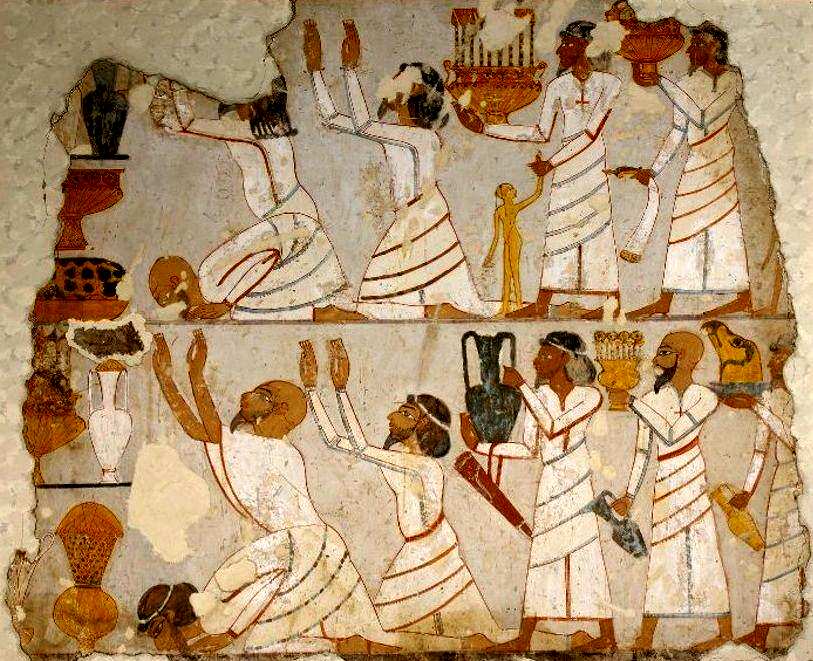
Slavery in Ancient Egypt: Sources

Figure 1.-- This is a wall painting fragmet from the tomb of Sebekhotep in Thebes, Egypt. Sebekhotep (or Sobekhotep) was an important treasury official in the reign of Thutmose IV (c. 1400-1390 BC) from Dynasty 18. He had the title "overseer of the seal", in effect the minister of finance. The fragment of painting, almost certainly, shows Sebekhotep receiving a group of strangers from Asia bringing tributes to the Pharaoh. The child in the top strip, as others that probably went backwards, is one of the gifts, given as slave of the Pharaoh. This was a source of slaves, but a minor one compared to war captives. The interesting question is why would apharoh appreciate the gift of a young child. A boy running round the palce would seem more of a nusance than a valuable gift. Given the number of slaves he had, you would think a gift like this would be a slave with some special tributes such as a beautiful young girl (rather than a child) or a strapping eunuch. Perhaps reader will have some insights here. A reader writes, "I don't know why they are bringing this gift. However, as you write, the child is only one of the gifts. Surely there were other slaves, perhaps children as well. We can see backwards a leg and an arm of another naked child. Perhaps there were also men and women. Usually the more valuable better gifts comes at the end. Anyway I think that the gifts were not only for Pharaho's personal use.
|
|
Like virtually all ancient civilizations, we know there were slaves in ancient Egypt and as in other countres, the orincipal source was war captives. The major source of slaves was war captives. This would include both the captured soldiers as well as the general civilian population of conquered lands. Egyptian sources report that Pharoh Thutmose III returned from a victorious campaign in Canaan with nearly 90,000 prisoners. Given the small size of ancient armies at the time, many if not most of these prisoners almost certainly were civilians. Any they would have been reduced to slavery in Egypt. Less cler is what happened to them and their descendents over time. Slaves might also be purchased in foreign lands like trade goods. Many Egyptian slaves came from neigboring regions, including Meroe and Kush, south of Egypt. There were also slaves from Libya to the west. And the know that there were slaves from the eastern area between the Hittites and Mesopotamia. And some people were of Egyptian origin. Small numbers may have been given as gigts in diplmastic exchanges, Criminals were sentenced to slavery. Some people sold thmselves or family members into slavery. No one knows the precise extent of Egyptian slavery. Records providing statistical data on such matters are not known. Egyptian sources confirm that foreign men and women were intermingled with Egyptian servants/slaves and seem to have outnumbered them. Egyptian masters appear to have preferred the foreign slaves. [Brooklyn Papyrus] The foreign slaves obtained in military campaigns commonly belonged to social groups of some status and thuus had a range of skills and education. Egytian slaves on the other hand were commonly criminals or perhaps abandoned foundlings that would have had to be raised and trained. Egyptian text provide the first evidence of the practice of selling one’s self into slavery in expectation of a certain level of support. Surviving texts describe a woman's agreement with a temple, "The female servant … has said before my master, Saknebtynis, the great god, I am your servant, together with my children and my children’s children. I shall not be free in your precinct forever and ever. You will protect me; you will keep me safe; you will guard me. You will keep me sound; you will protect me from every demon, and I will pay you 1¼ kita of copper . . . until the completion of 99 years, and I will give it to your priests monthly.’ [Piccione]
Sources
Brooklyn Papyrus. This is also known as the Brooklyn Medical Papyrus. It is an ancient Egyptian medical papyrus which is believed to have dated to the Egyptian 30th dynasty.
Piccione, Peter. The Status of Women in Ancient Egyptian Society.
HBC

Navigate the Boys' Historical Clothing Web Site:
[Return to the Main ancient Egyptian slavery page]
[Return to the Main ancient slavery page]
[Return to the Main slavery page]
[Return to the Main ancient Egypt page]
[Introduction]
[Activities]
[Biographies]
[Chronology]
[Clothing styles]
[Countries]
[Bibliographies]
[Contributions]
[Essays]
[FAQs]
[Glossaries]
[Images]
[Links]
[Registration]
[Tools]
[Boys' Clothing Home]
Created: 12:01 PM 8/25/2011
Last updated: 12:01 PM 8/25/2011



